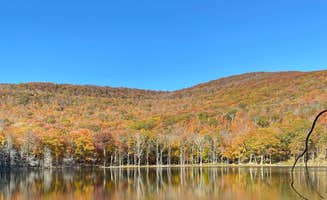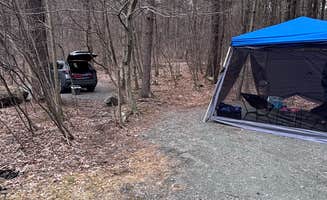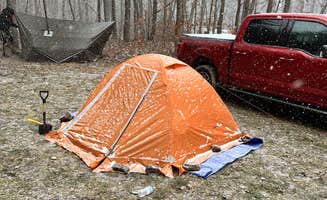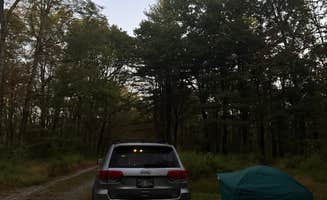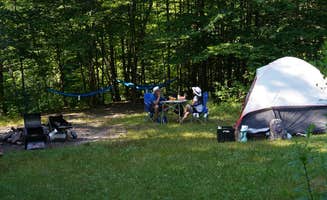Primitive camping near Stuyvesant, New York offers a mix of seasonal challenges with wet conditions often impacting site selection. The region's mixed deciduous forests provide natural wind barriers at lower elevations while higher sites experience significant temperature fluctuations between day and night, particularly in spring and fall. Most dispersed camping options require traveling 20-45 minutes from Stuyvesant proper, with accessibility varying dramatically depending on recent rainfall.
What to do
Explore forested trails: At Ushers Road State Forest, bicycle-friendly nature trails offer access to multiple potential campsites. "This trailhead provides access to bicycle-friendly nature trails. I explored both directions on my bike, riding approximately half a mile down each side. The terrain eventually transitions into a low-lying, swampy area, likely due to recent rainfall," notes a visitor.
Winter camping options: Burnt Rossman State Forest maintains year-round accessibility for primitive camping. As one camper reports, "Was a great location for winter camping. Site easily accessible from road. Beautiful, peaceful, great time!" The location offers stable ground conditions even during colder months.
Stream fishing opportunities: Primitive sites at Allaben provide direct access to fishing areas. "Trails to the fishing access across the road," notes one reviewer, making this a practical choice for anglers seeking camping with water access. The location remains accessible during shoulder seasons when other sites may be challenging to reach.
What campers like
Streamside camping: Betty Brook Camp offers primitive sites directly adjacent to flowing water. A regular visitor notes, "You camp on the stream. There is a couple of spots." This provides convenient water access for filtering or recreational use while maintaining a sense of solitude.
Established fire rings: Many primitive sites in the Catskills feature previously established fire rings with practical cooking features. At Allaben Primitive Campsites, campers appreciate that the "Fire pit [comes] with cooking griddle," allowing for more versatile meal preparation options without bringing specialized equipment.
Seasonal seclusion: The remoteness varies significantly by season. One Betty Brook camper comments, "Love to camp here all year long have been coming to the area for a couple of decades now. Remote. Sometimes you never see anyone. Sometimes you see some people." Weekday camping during spring and fall offers the highest likelihood of solitude.
What you should know
Road conditions impact access: Many primitive sites require navigating challenging roads. A visitor to Duck Pond Campsite shares, "After driving unpaved dirt road for a while, we arrived a surprisingly well maintained beautiful campsites. The pond is small so the mosquitos were not too bad." Vehicle clearance requirements increase after rainfall.
Cell service limitations: Connectivity varies significantly between sites, with higher elevations generally offering better reception. Most primitive areas maintain only intermittent coverage, which can complicate navigation. Sites closer to main highways typically provide more consistent connectivity.
Hidden established sites: Some primitive areas contain previously used sites that may not be immediately visible from main trails. At Ushers Road State Forest, "About 500 feet down the right-hand trail, there is a smaller path branching off to the left. This leads to a previously used campsite, approximately 200 feet from the main trail."
Tips for camping with families
Site selection for safety: When camping with children at Echo Lake, consider terrain variations. A camper advises, "We camped on the hill with a beautiful view of the whole lake and breeze." Higher sites often provide better supervision visibility and fewer insect issues.
Bug preparation: Insect conditions vary significantly by location and season. "Note, it can get swampy near the edge of the lake so you may want to bring bug spray," warns an Echo Lake camper. Spring and early summer typically see the highest concentration of insects, especially at water-adjacent sites.
Trail navigation with children: Some primitive sites require careful navigation with younger campers. At Echo Lake, "Other campsites are scattered and require navigating through small overgrown trails (wear pants)," highlighting the need for appropriate clothing and clear guidance when accessing more remote spots.
Tips from RVers
Small rigs only: Most primitive sites near Stuyvesant accommodate only compact RVs or truck campers. A NFR 273 Dispersed Camping Spot visitor notes, "Large enough for 2-3 vehicles or one large rig/RV." However, access roads often present the greatest limitation rather than the sites themselves.
Avoid wet conditions: Spring thaw and heavy rainfall periods create challenging driving conditions. "Many pull offs but a lot were too wet for my van and I was afraid of getting stuck. The road itself was in great condition though," reports an RVer at NFR 273, emphasizing the importance of seasonal timing for RV camping in these areas.
Space limitations: Even at more accessible sites, space constraints exist. At Burnt Rossman State Forest, a visitor notes, "This spot is right off the road. Nice and quiet. There is enough room for 2 to 3 campers. Parking across the street if it's wet. Entrance is soft." This highlights the need for advance planning when bringing larger vehicles.


